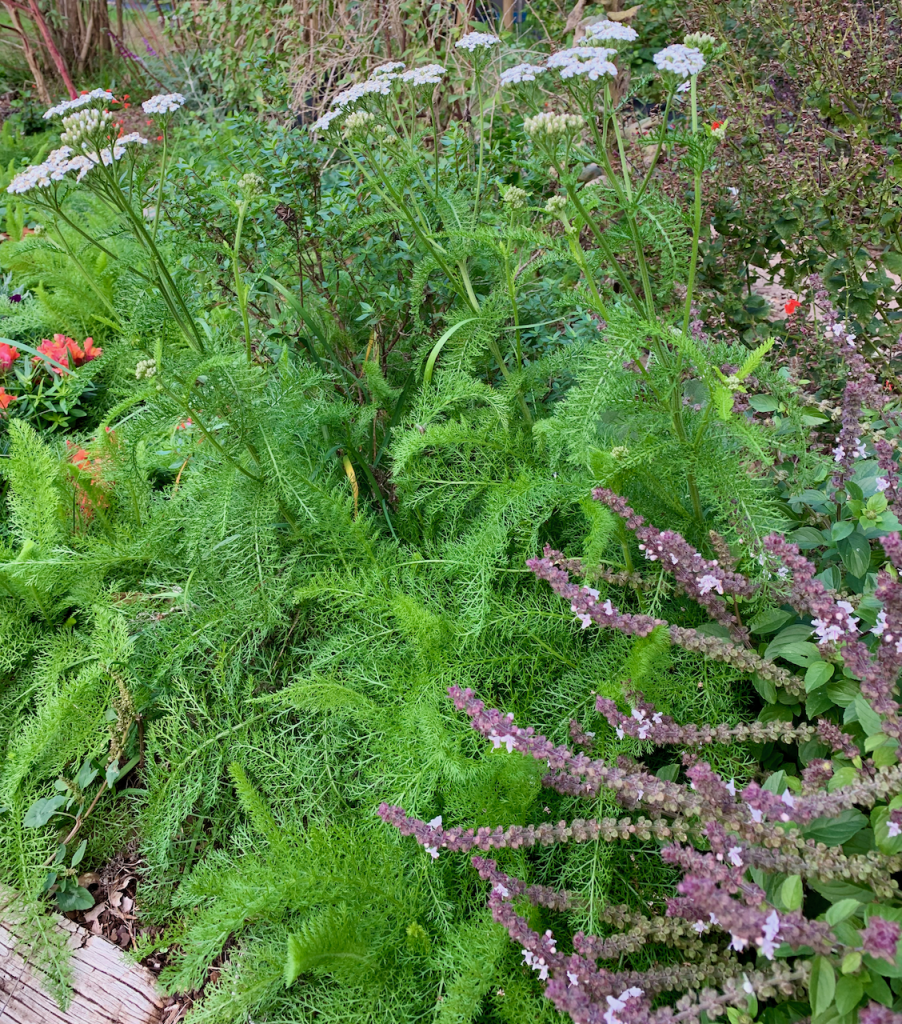
One reason I love Spring is because the Yarrow in the herb bed comes to life. It is a hardy perennial that has many uses. In the garden, it reliably grows lush and green in the Spring no matter how cold the winter was. Even when we had the Big Freeze in February 2021, it got down to 9 degrees here, the Yarrow came back strong and beautiful that Spring.
The flowers attract a host of beneficial insects such as hover flies, parasitic wasps, green lacewings and lady bugs, to name a few. The foliage provides habitat for the good bugs to hang out and lay their eggs. Planting Yarrow near your vegetables is a good way to encourage beneficial insects in the area.
It is attractive in the flower beds and also attracts honeybees and butterflies. You can find various colors of Yarrow at nurseries, but the white one is the native. I find it grows the best of all of them in my garden. Another definite benefit of Yarrow is it will grow in full sun, even here in South Central Texas.
Improve the soil
The extensive root system helps break up hard soils and allows more water and nutrient penetration. If you have an area where it is difficult to get anything to grow, plant Yarrow. After a year or so, you will be able to dig up the Yarrow and plant other crops there with better results.
For the compost
Yarrow is valuable as a compost activator and increases the nutrient value of your compost. Chop up she spent leaves and stalks and add them to the compost pile or compost tumbler.
Tea for your plants
You can also make Tea with the spent plants. Chop them up and infuse in boiling water overnight. The resulting infusion is high in copper and other nutrients and can be diluted and used to water your plants.
For first aid
The leaves have long been used to staunch a bleeding wound, reduce pain from the wound and act as an antimicrobial to keep infection at bay. The best leaves to use are the long, basal leaves coming out of the base of the stem of the plant. You can use the fresh leaves, but if you want to add Yarrow to your first aid kit, dry the leaves, powder them and store them in a container that will keep them dry. Use the powder on a bleeding wound, insect bite or, even, a nosebleed. Pack the wound with the dried powder. A scab will form with the powder and fall off as new skin forms underneath. For a nosebleed, pack a little of the dried powder in the nostril to stop the bleeding. After the bleeding stops, gently wash the powder out.
Herbal benefits
Tea made from the fresh or dried flowers is a known fever reducer and can calm an upset tummy. The flavor is rather bitter, but can be mixed with mint or lemon balm.
The fresh flowers are often extracted into alcohol as a tincture. Since the tea does tend to be bitter, many people prefer the tincture. To speed up the fever process, add 1 tsp of Yarrow Tincture to about 4 ounces of hot water and drink it several times a day. This encourages your natural immune system to speed up the healing process.
In the Garden
If you know someone who already has Yarrow growing, ask them to dig up a section for you. Plant it in a pot or the ground, keep it watered and within a week or so it should be established and grow for you. Keep it watered for about the first month. After that, the plant is very drought tolerant, although in really hot, dry weather it appreciates regular water.
Deer and cattle tend to leave Yarrow alone. I don’t know if sheep or goats eat it.
In conclusion
Yarrow is a satisfying and useful plant to have in a flower bed, herb garden or vegetable garden. It has so many uses. It is long lasting cut flower in arrangements. Look for it at plant centers, but you likely won’t find the native one there. For that, you’ll either have to get some from friend or in the wild. (Always get permission to dig plants on private property.) Some species can also be grown from seed. Many mail order seed companies carry yarrow, but it you’re looking for the native one, try American Meadows.
QUOTE FOR THE MONTHDiversity is being invited to the party; inclusion is being asked to dance.
-Verna Myers, author and speaker (b. 5 Apr 1960)
